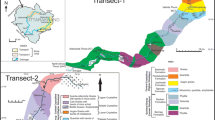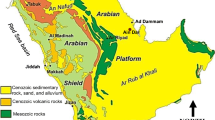Abstract
Rock strength is defined as the limit of the ability of a rock to resist stress or deformation without breaking. Testing methods recommended by ISRM (International Society of Rock Mechanics) and ASTM (American Standards Testing Material) include unconfined compressive strength (UCS), point load index (PLI), indirect tensile strength (ITS), Schmidt hammer rebound (SHR), sonic velocity (Vp and Vs), and slake durability index 2nd cycle (Id2). This contribution compares the results of these methods and explores the influence of rock composition and texture on Lower Miocene evaporites from Al Ain city, United Arab Emirates (UAE). These sedimentary rocks are common in the Arabian Peninsula as exposures or in the subsurface where they may constitute the foundations of buildings. A large number of UCS, PLI, ITS, SHR, SV, and Id2 tests were carried out on both core samples and rock blocks according to ASTM Standards. Examination of compositional and textural characteristics of representative rock samples was performed using XRD, XRF, polarized-light microscopy, and SEM. The results reveal variable correlations between the rock strength parameters with specific significant values between 0.53 and 0.72. The effect of composition and texture of the evaporitic rocks on their strength behavior is related to impurities such as clay minerals and celestite and grain interlocking textures. Despite the limited compositional variability of the evaporitic rocks (5–10%), the textural variability may present a challenging feature in rock strength testing and should be taken as a primary factor for consideration during applications.



Similar content being viewed by others
References
Abdelghany O, Abu Saima M, Arman H, Fowler A (2015) Gypsiferous bedrocks and soils of Abu Dhabi and their implications for engineering geozoning, In Proceedings of the Third International Conference on Engineering Geophysics-Leading through Creativity, Innovation and Sustainability. Al Ain, United Arab Emirates, November 15-18, EG26, 156-159.
Arman H, Hashem W, Abdelghany O, Aldahan A (2013a) On the accuracy of the in-situ Schmidt hammer tests on carbonate rocks. In Proceedings of Eurock 2013-Rock Mechanics for Resources, Energy and Environment-The 2013 ISRM International Symposium. Wraclow, Poland, 23-26 September, 189-193.
Arman H, Hashem W, Abdelghany O, Aldahan A (2013b) Evaluation of laboratory Schmidt hammer tests on carbonate rocks. In Proceedings of the Second International Conference on Engineering Geophysics, Al Ain, United Arab Emirates, 24-27 November, EG37, 234-237.
Arman H, Hashem W, Tokhi EM, Abdelghany O, Saiy EA (2014) Petrographical and geomechanical properties of the Lower Oligocene limestones from Al Ain city, United Arab Emirates. Arab J Sci Eng 39(1):261–271
Arman H, Hashem W, Abdelghany O, Aldahan A (2017) Effects of lithofacies and environment on in situ and laboratory Schmidt hammer tests: a case study of carbonate rocks. Q J Eng Geol Hydrogeol 50:179–186
ASTM D2845-08 (2008a) Standard test method for laboratory determination of pulse velocities and ultrasonic elastic constants of rock (Withdrawn 2017). ASTM International, West Conshohocken.
ASTM D2936-08 (2008b) Standard test method for direct tensile strength of intact rock core specimens (Withdrawn 2017). ASTM International, West Conshohocken.
ASTM D2938-95 (1995) Standard test method for unconfined compressive strength of intact rock core specimens. ASTM International, West Conshohocken.
ASTM D4543-08e1 (2008c) Standard practices for preparing rock core as cylindrical test specimens and verifying conformance to dimensional and shape tolerances (Withdrawn 2017). ASTM International, West Conshohocken.
ASTM D4644-16 (2016a) Standard test method for slake durability of shales and other similar weak rocks. ASTM International, West Conshohocken.
ASTM D5731-16 (2016b) Standard test method for determination of the point load strength index of rock and application to rock strength classifications. ASTM International, West Conshohocken.
Boukhary M, Abdelghany O, Bahr S (2002) Nummulites alsharhani n.sp. (Late Lutetian) from Jabal Hafit and Al Faiyah: western side of the Northern Oman Mountains, United Arab Emirates. Revue Paleobiol Geneve 21:575–585
Erguler ZA, Ulusay R (2009) Water-induced variations in mechanical properties of clay-bearing rocks. Int J Rock Mech Min 46:355–370
Hawkins AB (1998) Aspects of rock strength. Bull Eng Geol Environ 57:17–30
Heidari M, Khanlari GR, Kaveh MT, Kargarian S (2012) Predicting the uniaxial compressive and tensile strengths of gypsum rock by point load testing. Int J Rock Mech Min 45(2):256–273
Marinos P, Hoek E (2001) Estimating the geotechnical properties of heterogeneous rock masses such as Flysch. Bull Eng Geol Environ 60:85–92
Salah H, Omar M, Shanableh A (2014) Estimating unconfined compressive strength of sedimentary rocks in United Arab Emirates from point load strength index. J Appl Math Phy 2:296–303
Styles MT, Ellison RA, Arkley SLB, Crowley Q, Farrant AR, Goodenough KM, Mckervey JA, Pharaoh TC, Phillips ER, Schofield D, Thomas RJ (2006) The geology and geophysics of the United Arab Emirates. In: Geology, vol 2. Ministry of Energy, United Arab Emirates
Thomas RJ, Ellison RA, Farrant AR, Goodenough KM, Kimbell GS, Newell AJ, Pharaoh TC, Phillips ER, Styles MT (2014) Geologic evolution of the United Arab Emirates-over six hundred million years of Earth history. Ministry of Energy, United Arab Emirates
Yilmaz I (2010) Influence of water content on the strength and deformability of gypsum. Int J Rock Mech Min 47:342–347
Yilmaz I, Sendir H (2002) Correlation of Schmidt hardness with unconfined compressive strength and Young’s modulus in gypsum from Sivas (Turkey). Eng Geol 66(3):211–219
Yilmaz I, Yuksek AG (2008) An example of artificial neural network (ANN) application for indirect estimation of rock parameters. Int J Rock Mech Min 41(5):781–795
Yilmaz I, Yuksek AG (2009) Prediction of the strength and elasticity modulus of gypsum using multiple regression, ANN and ANFIS models. Int J Rock Mech Min 46(4):803–810
Acknowledgments
This research was funded by the United Arab Emirates University, Research Affairs with the research project number UPAR 2016 – 31S252. The authors wish to express special thanks to the research assistant, technicians and students who participated in the field and laboratory work.
Author information
Authors and Affiliations
Corresponding author
Additional information
Responsible Editor: Amjad Kallel
This paper was selected from the 1st Conference of the Arabian Journal of Geosciences (CAJG), Tunisia 2018
Rights and permissions
About this article
Cite this article
Arman, H., Abdelghany, O., Saima, M.A. et al. Strength estimation of evaporitic rocks using different testing methods. Arab J Geosci 12, 721 (2019). https://doi.org/10.1007/s12517-019-4916-9
Received:
Accepted:
Published:
DOI: https://doi.org/10.1007/s12517-019-4916-9




